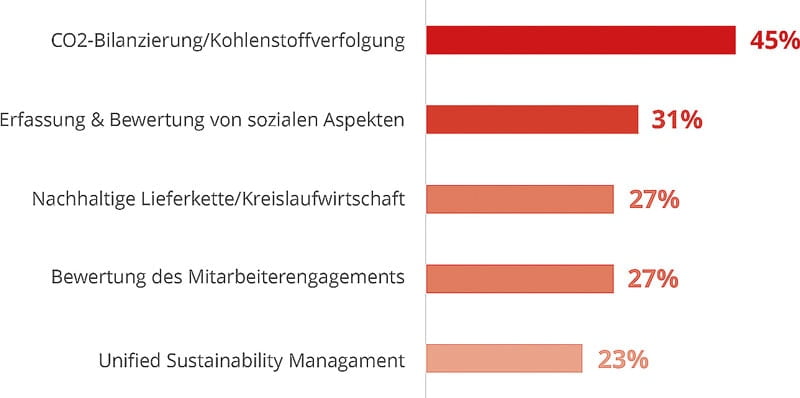Sustainability with IT


Companies in Germany are not only facing changing consumer behavior, but also stricter regulations and investor requirements in terms of sustainability. The IDC study "IT and Sustainability in Germany 2022" has revealed the extent to which sustainability has arrived in companies and IT departments and the challenges organizations face in implementing sustainability initiatives. IDC surveyed 200 companies with more than 100 employees across all industries in Germany in December 2021 to gain detailed insights into the planning, challenges and drivers related to sustainability initiatives by and with IT.
The pandemic has given a significant boost to the importance of sustainability at 80 percent of the companies surveyed in Germany. According to their own statements, 38 percent of the companies surveyed already have a company-wide approach to sustainability, and another 40 percent have individual programs. The biggest drivers here are customer demand for environmentally friendly products and offerings and improvements in operational or production efficiency. Nearly all organizations said they plan to achieve their sustainability goals by 2030, which includes a consistent focus on circular economy principles (44 percent) and, most importantly, working with suppliers and partners who share their sustainability goals (41 percent).
The biggest challenges to achieving current sustainability goals include a lack of transparency about processes and data (25 percent), employee engagement at the operational level (23 percent), and a lack of awareness about how technology can help increase sustainability (21 percent). "The fact that one in five companies in Germany apparently has no clear idea of how IT can be used in concrete terms in terms of sustainability is, on the one hand, surprising"says Elena Georg, project manager at IDC. "But it also fits the picture when we look at where German companies stand in terms of digitization."
Responsible Design
As sustainable business regulations are introduced, for example, setting levies on non-recycled plastic packaging, SAP's Responsible Design and Production solution allows companies to move more quickly to circular economy practices. The solution provides companies with an overview of the material flows in their processes and helps them track and comply with changing regulations, particularly on product packaging and plastics. As companies increasingly develop sustainable products, controlling materials and managing regulatory data is becoming one of the most complex challenges in today's consumer goods industry.
"The circular economy is based on three principles influenced by design: Avoid waste and pollution, reuse products and materials over and over again, and regenerate natural systems. Digital solutions play an important role on the path to the circular economy", says Andrew Morlet, CEO of the Ellen MacArthur Foundation. "It allows companies to incorporate circular economy practices into all of their operations - from product design that takes waste prevention into account from the start to tracking the life cycle of the materials used."
The SAP solution is designed to help companies integrate circular economy principles into their core processes to avoid waste and add value by designing products that are sustainable from the start. For example, a shampoo brand manager gets an overview of the entire product lifecycle, including extended producer responsibility (EPR) obligations and levies on plastic packaging in different markets. He is thus able to modify the design to reduce waste and make appropriate decisions to reduce the costs of the downstream waste system.
"Every year, we consume almost twice as many resources as our planet can provide again. Companies can make a critical contribution here to longer resource use in our systems by focusing on smart, responsible product design that reuses rather than discards resources.", says Scott Russell, member of the SAP SE Executive Board and head of Customer Success. "Designing products that eliminate waste and use environmentally responsible materials is fundamentally very complicated. But SAP Responsible Design and Production reduces that complexity and serves as a benchmark for our customers to provide products that are recycled back into the production cycle and ultimately achieve a regenerative economy."
While energy management or employee training for greater environmental awareness are implemented today, the purchase of fair IT products, the development of smart buildings and the life cycle assessment of products and services are among the initiatives in the future. Optimizing the efficiency of supply chains, manufacturing processes, machines or the vehicle fleet is something that every second respondent wants to tackle in the future - all of which are measures that IT makes possible in the first place.

IT strategy
Sustainability per se has a high priority in IT departments and is already taken into account, at least selectively, in strategic IT decisions at two out of three companies. In around 28 percent of the companies, however, the sustainability aspect is already a fixed component of a holistic IT strategy, with a clear upward trend. For half of the respondents, sustainability is already an important influencing factor when purchasing IT. In addition, almost one-third of companies plan to invest more than 30 percent of their IT budget in sustainable products and services over the next 24 months, while half of the companies plan to spend between ten and 29 percent of their budget on sustainability.
The immense sustainability potential in IT already becomes clear when looking at the useful life of IT hardware, because the end of the useful life is unsurprisingly still defined in companies primarily in terms of depreciation and the term of the contract and not in terms of performance or wear and tear. When hardware has reached the end of its useful life, it is primarily recycled (29 percent), resold (27 percent) or returned to the equipment manufacturer (24 percent). In the area of hardware in particular, the printer infrastructure plays an important role in connection with the sustainability strategy for almost 90 percent of the companies surveyed.
A good 70 percent of those surveyed believe that modern, intelligent printers and multifunction devices will help to reduce power consumption and CO2 emissions in this area and optimize processes. "It's clear that implementing sustainability measures requires new approaches and innovations that companies often can't create on their own"says Marco Becker, project manager at IDC. "As a result, external partners, sustainable ecosystems and, in the future, a focus on their supply chains in particular, are important to almost two-thirds of respondents in achieving their sustainability goals. We expect to see increasing investment in sustainable ecosystems in the future, with companies increasingly turning to IT providers who have the networks in place."
The study shows that the topic of sustainability is already having an impact on German companies and will continue to grow as a result of increasing demands from customers, politicians and investors. IT clearly has a key role to play in achieving greater sustainability, as it can both effectively accompany sustainability initiatives by means of data processing and analysis and be the basis for new processes and products with a positive impact on sustainability. IT therefore not only supports the implementation of sustainability measures - they are often made possible in the first place through the use of IT. For example, by providing cloud, IoT or AI, IT creates the necessary transparency within the company itself as well as along the supply chain.




